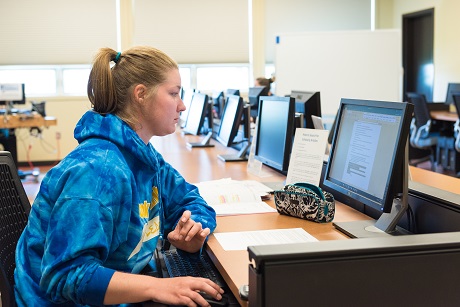Learning Up Close, From Afar
With a strong heritage in eLearning, COCC moves to fully embrace the teaching needs of the COVID-19 era
For Jessica Thaxton of Bend, her hard-earned college degree might not culminate with
an in-person graduation this June, owing to the current climate of social distancing.
But then again, her education wasn’t exactly in-person either.
“Out of 22 courses taken prior to the COVID-19 precautions, I took 17 of those online,”
said the Central Oregon Community College (COCC) computer information systems student,
focusing her studies on web development. “As someone who works full-time, the availability
of many online courses was the primary determining factor in my decision to return
to school. Without online options, my degree may have been unobtainable.”
Plugging into an online education is now a sign of the times — virtual campuses are
a necessity as the world navigates the coronavirus pandemic. But it’s long been a
focus at COCC. “Pharmacy tech, computer information systems and our business program
are all areas where a significant portion of the courses are available online,” said
Betsy Julian, Ph.D., vice president of instruction, pointing to three of the college’s
biggest distance-learning programs.
Many other COCC academic paths offer the convenience of some online and hybrid components.
In fact, roughly 12 percent of all college classes during the 2018-19 academic year
were delivered online. For a number of years, students at COCC have had a wide range
of virtual studies to choose from — from classes in microbiology and ethnic studies
to early childhood education and health & human performance. Last year, four out of
10 students utilized those learning opportunities. Now, of course, all learning is
offered remotely until the tide turns on COVID-19. But that can foster unexpected
connection.
“The truth is,” said Michael Murphy, Ed.D., director of eLearning at COCC, “online
courses offer students great access to faculty. For example, many use email, blogs,
interactive discussions, journaling, announcements, chat sessions and conferencing
tools to connect with their students in a myriad of formats, which can increase their
interactions with faculty.”
Backed by an established eLearning department, and drawing on honed resources to support
the adaptability of COCC’s instructors, the college’s learning environment is quickly
shifting gears with tech like Blackboard and Zoom, even firing up some improvisation.
“My game plan is to create virtual field trips by visiting field sites with a GoPro
and a field assistant,” said Hal Wershow, assistant professor of geology. “The goal
being to get the camera up close and personal with the rocks, just like the students
would be doing.”
Wershow knows he might have to find some new basalt flows and sedimentary deposits
to weave into his lesson plans — due to widespread state and federal land access closures
— but his classes will capture the same observation-and-interpretation elements they
always did, along with the application of newfound knowledge. “I’ll employ the same
three-step learning cycle approach I would use on a normal field trip,” he added.
“The truth is,” said Michael Murphy, Ed.D., director of eLearning at COCC, “online courses offer students great access to faculty. For example, many use email, blogs, interactive discussions, journaling, announcements, chat sessions and conferencing tools to connect with their students in a myriad of formats, which can increase their interactions with faculty.”
Normal, for now, does mean dabbling with different tools. For Anne Zmyslinski-Seelig,
Ph.D., assistant professor of speech communication, that boils down to identifying
what works. “I’m trying something called Flipgrid for class introductions,” she said.
“It’s a platform where people can share short videos with each other. In my public-speaking
class, specifically, I think it’s important to establish ‘face time’ as early as we
can.”
In Shin Yeon Jeon’s ceramics classes, the collective hum of spinning pottery wheels
won’t serve as a studio soundtrack as it typically does. The instructor, though, is
determined to give students a feel for the space anyway. She’s made a video tour of
the art studio along with a series of videoed demos. “It is so important that students
are able to express themselves in this time of isolation so I wanted to make sure
I could provide that opportunity for them,” she said. Students will have materials
provided by the department or available from the COCC bookstore and online stores.
With an artist’s channel-the-moment outlook, Jeon sees potential in these trying times:
“There may even be amazing pieces coming out by the end of the spring term because
most students will work alone, and they will have fewer interruptions.”
Certainly, remote instruction forces a new approach. “The interesting thing about
good online course design is that it all translates to good face-to-face course design
as well,” said Ken Swartwout, department chair of computer information systems. “Putting
a class online forces the instructor to explicitly address all the weakest parts of
the course — identify why they are weak and put in the support or tools to address
the shortcoming.”
Jessica Thaxton will soon earn her associate degree, use it to expand her world with
a new career. “I would love to combine the coding and programming skills taught at
COCC with my passion for art and design, bringing the artistic and technical sides
of software development together,” she shared. It’s a merging of passions and abilities
that found strong traction through distance learning.
By Mark Russell Johnson, COCC College Relations

